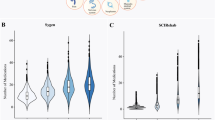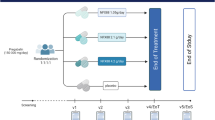Abstract
Twenty-two spinal cord injured men (mean age 35.2 years) referred because of impotence were treated with intracavernosal vasoactive agents. Papaverine 2–20 mg, papaverine 40 mg plus phentolamine 0.5 mg or prostaglandin E1 (1–20 ug) were used. Nineteen responded and were taught to self administer the medication with varying degrees of assistance from their partners. Fourteen men participated in a postal survey; 12 (86%) continued to use the drugs every 1 to 4 weeks and reported satisfaction with the method. Partner responses were positive in half of the group and when not so it influenced the patients to abandon or reduce the frequency of treatment. Counselling was essential to allay anxiety. Clinical management was not compromised and side effects were minimal. Overall we found this treatment effective, safe and worthwhile.
Similar content being viewed by others
Log in or create a free account to read this content
Gain free access to this article, as well as selected content from this journal and more on nature.com
or
References
Collins K P, Hackler R H (1988) Complications of penile prostheses in the spinal cord injury population. J Urol 140: 984–985.
Brindley G S (1983) Cavernosal alpha-blockade: a new technique for investigating and treating erectile impotence. B J Psychiatry 143: 332–337.
Virag R, Frydman D, Legman M, Virag H (1984) Intracavernous injection of papaverine as a diagnostic and therapeutic method in erectile failure. Angiology 35: 79–87.
Zorginiotti A W, Lefleur R S (1985) Auto-injection of vasoactive drug combination for vasculogenic impotence. J Urol 133: 39–41.
Earle C M, Keogh E J, Wisniewski Z S et al (1990) Prostaglandin E1 therapy for impotence, comparison with papaverine. J Urol 143: 57–59.
Watters G R, Keogh E J, Earle C M (1988) Experience in the management of erectile dysfunction using the intracavernosal self-injection of vasoactive drugs. J Urol 140: 1417–1419.
Momose H, Natsume O, Yamamoto M, Suemori T, Yamada K (1987) Intracavernous injection of papaverine hydrochloride for impotence in patients with spinal cord injury. Hinyokika Kiyo 33(7): 1065–1069.
Wyndaele J J, de Meyer J M, de Sy W A, Claessens H (1986) Intracavernous injection of vasoactive drugs, an alternative for treating impotence in spinal cord injury patients. Paraplegia 24(5): 271–275.
Bodner D R, Lindan R, Leffler E, Resmick M I (1987) The application of intracavernous injection of vasoactive medication for erection in men with spinal cord injury. J Urol 138: 310–311.
Sidi A A, Cameron J S, Dykstra D D, Reinberg Y, Lange P H (1987) Vasoactive intracavernous pharmacotherapy for the treatment of erectile impotence in men with spinal cord injury. J Urol 138: 539–542.
Lloyd L K, Richards J S (1989) Intracavernous pharmacotherapy for management of erectile dysfunction in spinal cord injury. Paraplegia 27: 457–464.
Keogh E J, Tulloch A G S, Csillag E R et al (1988) The diagnosis and management of impotence. Med J Aust 148: 494–498.
Hu K N, Burks C, Christy W C (1987) Fibrosis of tunica albugínea: complication of long-term intracavernous pharmacological self-injection. J Urol 138: 404–405.
Juenemann K P, Benedict Yen T S, Lue T F, Tanagho E A (1988) The effect of chronic papaverine treatment on simiean erectile tissue. In: Proceedings of the Third Biennial World Meeting on Impotence, Boston, Massachusetts, abstract 80.
Adaikan P G, Tai N y, Lau L C, Karim S M, Kottegoda S R (1984) A comparison of some pharmacological actions of prostaglandin E1, 6-oxo-PGE1 and PG12. Prostaglandins 27: 505–516.
Virag R, Adaikan P G (1987) Effects of prostaglandin E1 on penile erection and erectile failure. Letter to the Editor. J Urol 140: 1417–1419.
Author information
Authors and Affiliations
Rights and permissions
About this article
Cite this article
Earle, C., Keogh, E., Ker, J. et al. The role of intracavernosal vasoactive agents to overcome impotence due to spinal cord injury. Spinal Cord 30, 273–276 (1992). https://doi.org/10.1038/sc.1992.68
Issue date:
DOI: https://doi.org/10.1038/sc.1992.68
Keywords
This article is cited by
-
Intracavernous prostaglandin E1 in erectile dysfunction
Journal of Molecular Medicine (1994)



